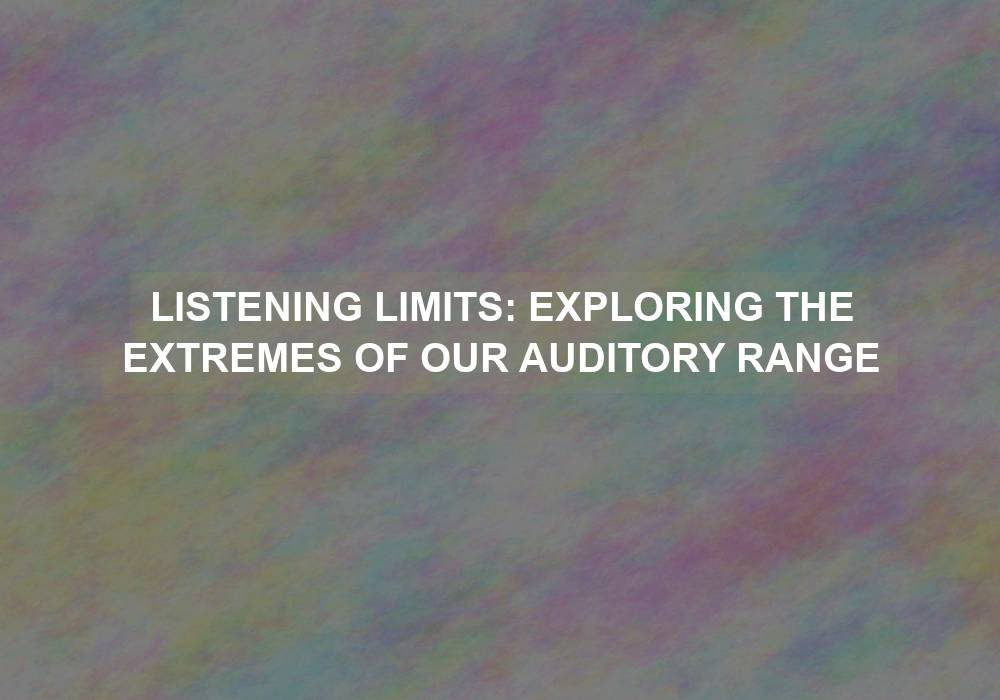The human auditory system is a remarkable sensory mechanism that allows us to perceive and interpret sound. From the faintest whisper to the deafening roar of a jet engine, our ears are versatile instruments that enable us to experience the world of sound. In this article, we will delve into the fascinating topic of auditory range, exploring the limits of what we can hear and the factors that influence our perception of sound.
Understanding Auditory Range
The auditory range refers to the range of frequencies that our ears are capable of detecting. These frequencies are measured in Hertz (Hz) and encompass the entire spectrum of sound. The human hearing range typically spans from 20 Hz to 20,000 Hz, although it can vary based on individual factors such as age and exposure to loud noises.
The Upper Limit of Auditory Range
At the upper end of our auditory range, some individuals may be able to perceive sounds above 20,000 Hz, a region commonly known as ultrasound. Ultrasound, although beyond the range of human speech and music, has various applications in fields such as medicine and technology. For instance, ultrasound imaging is used in obstetrics to monitor the development of fetuses, and it is utilized in sonar technology for underwater navigation.
It is important to note that the ability to hear ultrasonic frequencies diminishes with age. As we grow older, our sensitivity to high-pitched sounds decreases due to natural physiological changes in the ear. This phenomenon, known as presbycusis, is a common occurrence and affects the majority of individuals over the age of 65.
The Lower Limit of Auditory Range
On the other end of the spectrum, the lower limit of our auditory range is determined by the threshold of hearing. The threshold of hearing refers to the quietest sound that can be detected by the average human ear. This threshold is typically around 0 dB (decibels) at a frequency of 1,000 Hz.
Below the threshold of hearing, we enter the realm of infrasound, which encompasses frequencies below 20 Hz. Infrasound is often generated by natural phenomena such as earthquakes, volcanoes, and thunderstorms. While we may not consciously perceive infrasound, it can still affect us physiologically and emotionally. Some studies suggest that exposure to infrasound can induce feelings of unease or fear in individuals.
Factors Influencing Auditory Perception
While the human auditory system is remarkably adaptable, several factors can influence our perception of sound. Let’s explore some of these factors in detail:
Age
Age plays a significant role in determining our auditory range. As mentioned earlier, as we age, the structures within the ear responsible for detecting high-frequency sounds begin to deteriorate. This age-related hearing loss, or presbycusis, typically starts with a decline in sensitivity to higher frequencies, making it harder to hear and understand speech or distinguish certain sounds.
Additionally, older individuals may also experience difficulties in hearing conversations in noisy environments, as their ability to filter out background noise diminishes. This can lead to social isolation and communication challenges.
Exposure to Loud Noises
Exposure to loud noises, especially for prolonged periods, can damage the delicate structures of the inner ear, leading to noise-induced hearing loss. This type of hearing loss is becoming increasingly prevalent, particularly among young individuals who frequently listen to music at high volumes through headphones or attend loud concerts without adequate hearing protection.
It is essential to be aware of the volume levels when listening to music or attending noisy events. Using noise-canceling headphones, taking regular breaks, and keeping the volume at a moderate level can help prevent long-term hearing damage.
Genetics
Our genetic makeup also plays a role in determining our auditory abilities. Some individuals may be genetically predisposed to hearing impairments, while others may have enhanced sensitivity to certain frequencies. Genetic factors can influence various aspects of auditory perception, including the ability to detect subtle differences in pitch or the susceptibility to noise-induced hearing loss.
Understanding one’s genetic predispositions can help individuals take proactive measures to protect their hearing and seek appropriate interventions if necessary. Genetic testing may provide valuable insights into an individual’s risk for hearing loss and guide personalized hearing conservation strategies.
Environmental Factors
The environment in which we live and work can significantly impact our auditory perception. Individuals who are constantly exposed to loud industrial noise or work in environments with high ambient noise levels may experience a gradual decline in their hearing abilities over time. This occupational noise exposure can lead to permanent hearing damage if proper hearing protection measures are not implemented.
Conversely, individuals residing in quieter environments may have a more acute sense of hearing and be more sensitive to subtle auditory cues. The soundscape of our surroundings, whether it’s the bustling city streets or the tranquil countryside, can shape our auditory perception and influence our overall well-being.
Personal Listening Habits
Our personal listening habits can also affect our auditory range. Regular exposure to loud music or continuous use of headphones at high volumes can lead to long-term hearing damage. It is essential to adopt safe listening practices, such as taking regular breaks, using noise-canceling headphones, and keeping the volume at a moderate level, to protect our hearing health.
Additionally, practicing active listening techniques, such as focusing on the speaker and minimizing distractions, can improve our ability to understand and interpret sounds accurately. Developing healthy listening habits from an early age can contribute to lifelong hearing wellness.
Conclusion
The human auditory system is a complex and remarkable mechanism that allows us to experience the richness of sound. Understanding the limits of our auditory range and the factors that influence our perception of sound is crucial for maintaining our hearing health. By being aware of the potential risks and taking proactive measures to protect our ears, we can continue to enjoy the wonders of sound throughout our lives.
